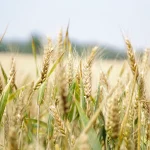A kilogram of wheat gives 70 to 80 decagrams of flour, around 60 decagrams goes into a kilo of bread. At the same time the price of bread in Croatia has reached nearly 10 Kuna, elsewhere in Europe even more. But in European markets this most important grain sells for 5 to 10 percent higher than in Croatia
The starting bell for the sale price begins now, when combine harvesters enter fields of wheat. Comparing Croatian farmers to European ones is Matija Brlošić, president of the Croatian Agriculture Chamber (HPK) and Ernest Nad of the Croatian Chamber of Commerce, Tportal.hr writes on June 29, 2016.
Croatia sowed five percent more wheat last autumn according to data from the State Bureau of Statistics. It covers 148,000 acres where a record harvest of 800,000 tonnes is expected, while Croatian demand this year has been reduced to around 150,000 tonnes due to higher import of flour and baked products threatening the domestic milling and baking industry, with stockpiles in world markets too. In such circumstances a lower sale price is expected. Last year it was 1.1 Kuna, possibly going under 1 Kuna this year.
“Croatian producers are lagging behind Europe some 15 to 20 years. A standard is used abroad, which are the proteins that dictate sales. We are currently unable to produce high quantities of that quality as it takes years due to a change in sort. So we’re having problems placing the goods. Although other parameters exist in wheat which are much more important for baked products, such as gluten, by which Croatian wheat is excellent, it is unfortunately not even mentioned in European standards and codes,” said Matija Brlošić.
Croatian farmers cannot influence a change in standards although they are part of the European market, as their production amounts to less than 1% of total production. The only thing remaining is to switch to the grain with higher protein content demanded in Europe.
“Slavonia and Vojvodina are God-given for growing the best wheat in Europe. But genetics went another way to protect the European market. Their wheat is rained on for three to four months, it is protected from disease several times and chemically kept alive while ours is sprayed once, maybe twice and is therefore healthier,” Brlošić explains.
Domestic producers of this grain who aim to harvest around nine tonnes per acre need to invest around 8,000 Kuna and hope for favourable weather conditions European farmers have had an advantage for over 20 years. Their investment in mechanisation and buildings are subsidized by more than a half which makes their starting investment beyond comparison with Croatia.
“At the start everything is more expensive here. The price of protective materials, mineral fertilizer is somewhat cheaper than in Croatia. Their yield per acre reaches ten or more tonnes. Our wheat is harvested at the end of June and start of July as temperatures soar to 35 Celsius, while theirs is still green and harvest begins in August although it was seeded two months before ours. So it vegetates four months longer and can surely give better yield. We have a shorter period and get the quality they don’t have, but they focused on another quality,” he continues.
Even though wheat in Croatia from a financial perspective is getting harder to grow, producers are staying faithful.
“Croatia set a record last year by the low sale price, something to be repeated again. I hope farmers will look for buyers in other places as well as in export,” Brlošić adds.
For the last five years, depending on the year and production, Croatia has exported between 200,00 and 400,000 tonnes. The largest buyers are Italians, but also Bosnians, Hungarians and other EU countries.
“If we have the quality, sales are guaranteed. The argument is over the sale price. I hope to reach a compromise there as prices are dumped during harvest season, lower than the market values. So producers will recommend free storage until October, when prices should be higher,” said Ernest Nad from the Osijek HGK.








